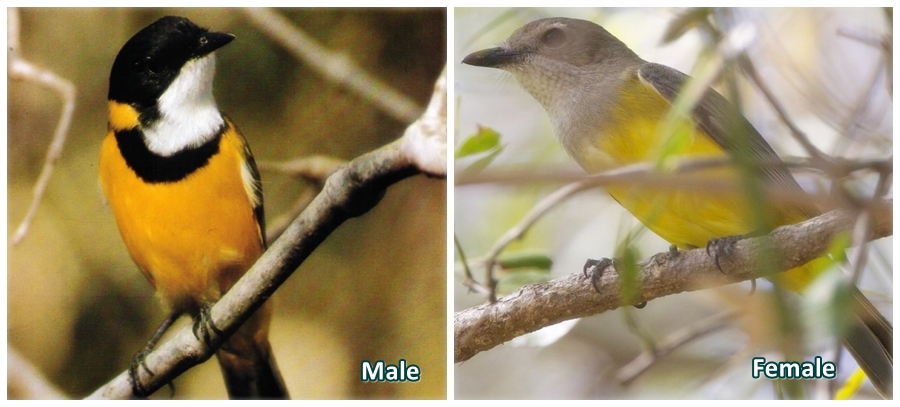Mangrove Golden Whistler (Pachycephala melanura) is endemic to mangrove forests, as its name suggests. The bird belongs to the family Pachycephalidae, which is a group of species of birds living in mangroves. There are several areas in northern Australia where the species can be found, wherever there are extensive stands of Rhizophora-Bruguiera forest, and only occasionally does it stray out into fringing monsoon scrub.
As with the Golden Whistler, this species also forages solitarily or in dispersed pairs in the middle strata of the vegetation, about a meter above the ground, in the middle strata of the vegetation. Among branchlets and foliage beneath the forest canopy, this insect-gleaning bird hops methodically and alertly, gleaning for insects and sometimes diving for small crabs and mud in the mangroves and up on the tidal debris to be found. There is an undulating motion to the flight from tree to tree within the forest.
The Mangrove Golden Whistlers appear to be sedentary, and it is possible that established pairs may remain in the same territory year-round. There is sporadic singing among males throughout the year, but this is more prominent during the breeding season. There is a break in the distribution of the Mangrove Golden Whistler in Australia at Eighty Mile Beach, but this does not coincide with the limits of the two races on the beach.

Only in the northern Kimberleys around Port Warrender, some distance north of where the paler western race meets and intergrades with the more richly colored northern form, is it possible to find the paler western race on both sides of the break. As their bills are longer than those of the related Golden Whistler, these species may be better able to take advantage of their main prey in the mangroves: grubs, ants, shield bugs, leaf and lace beetles, and other insects. It is also known as the black-tailed whistler or the robust whistler. In terms of size, the mangrove golden whistler is approximately 150–160 mm in length.
In terms of identifying the male bird, the crown, sides of the head, and band across the upper breast are black; the collar is golden-yellow; and the rest of the upper parts are golden-olive. The tail can either be all black or graded from golden-olive to black as a base color. Wing quill edges are gray in color. The underparts are deep yellow, except for the throat, which is white. The color of the eyes is ruby. The bird has black feet and a bill.
The female bird’s head is gray; the rest of the upper parts are dull olive; the tail is dusky (northern race) or olive-grey (western race). The throat is white-flecked brown, and the rest of the underparts are yellow (northern race), or the underparts are creamy-white with a yellow undertail (western race).
Immature: In the first year, the upper part of the bird is washed russet; the tail is olive with black shafts; the throat is white with dark fringes; the rest of the underparts are buff; the undertail coverts are bright yellow; the eye is brown; and the bill is dull brown. During the second year, they resemble females.
Golden Whistler’s call and song resemble those of Mangrove Golden Whistler. Nesting and breeding occur between October and December. The nest is placed in an upright leafy fork of mangrove or another tree among adjacent coastal vegetation; nests are loose cups of grass and rootlets lightly bound with cobwebs. The bird laid 2 or 3 eggs. The eggs are buff or stone-colored, spotted with dark red-brown and grey, often in zones at the larger end; oval, 21 x 16 mm.
The mangrove golden whistler can be found in mangroves and adjacent scrub along northern Australia’s coast, from Carnarvon, WA, to Repulse Bay, Queensland. The Bismarck Archipelago and eastern New Guinea are also included. There are probably four or five races—two in Australia.
Subspecies: There are five subspecies recognized.
-
Pachycephala melanura dahli – This species is found in the Bismarck Archipelago and south-eastern New Guinea.
-
m. violetae – This race is found in northern Australia.
-
m. melanura – This mangrove race is found in north-western Australia.
-
m. robusta – This is also known as the “robust whistler.”. This subspecies is found in northern Australia.
5. Robust whistler (P. m. spinicaudus) initially described as a separate species in the genus Pteruthius. This race is found in southern New Guinea and islands in the Torres Strait.

Read More: Gilbert’s Whistler (Pachycephala inornata)






